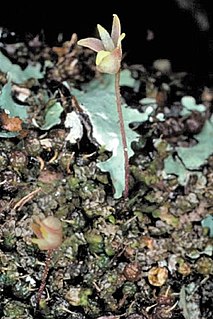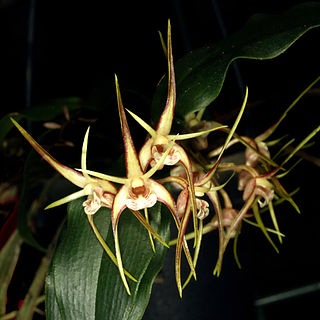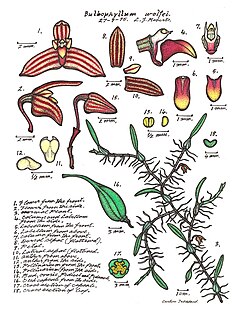
Bulbophyllum globuliforme, commonly known as the green bead orchid, miniature moss-orchid or hoop pine orchid, is a species of epiphytic orchid with tiny spherical pseudobulbs, scale-like leaves and small cream-coloured flowers with a yellow labellum. It grows on the scaly bark of hoop pine, mostly on the McPherson Range on the New South Wales/Queensland border in eastern Australia. Because of its small size it is often dismissed as moss.

Dendrobium discolor, commonly known as antler orchids, are epiphytic or lithophytic orchids in the family Orchidaceae. They have cylindrical pseudobulbs, each with between ten and thirty five leathery leaves, and flowering stems with up to forty mostly brownish or greenish flowers with wavy and twisted sepals and petals. Antler orchids occur in northern Australia, New Guinea and Indonesia and there are several subspecies and varieties.

Dendrobium tetragonum, commonly known as the tree spider orchid, is a variable species of epiphytic or lithophytic orchid endemic to eastern Australia. Tree spider orchids are unusual in having pendulous pseudobulbs that are thin and wiry near the base then expand into a fleshy, four-sided upper section before tapering at the tip. There are only a few thin but leathery leaves at the end of the pseudobulbs and up to five flowers on relatively short flowering stems. To allow for the variations in the species there are five subspecies and a variety, some with a unique common name.
Bulbophyllum argyropus, commonly known as the silver strand orchid, is a species of epiphytic or sometimes lithophytic orchid that is endemic to eastern Australia, including Lord Howe and Norfolk Islands. It has crowded pseudobulbs, tough, dark green leaves and up to four small whitish to yellowish flowers with an orange labellum.

Bulbophyllum baileyi, commonly known as the fruit fly orchid, is a species of epiphytic or lithophytic orchid that is native to Queensland and New Guinea. It has coarse, creeping rhizomes, curved, yellowish pseudobulbs with a single thick, fleshy leaf, and a single cream-coloured flower with yellow, red or purple spots. It grows on trees and rocks in open forest, often in exposed places.
Bulbophyllum bracteatum, commonly known as the blotched pineapple orchid, is a species of epiphytic or sometimes lithophytic orchid that is endemic to eastern Australia. It has crowded pseudobulbs, tough, pale green or yellowish leaves and up to twenty five cream-coloured to yellowish flowers with purplish or reddish blotches. It usually grows in the tops of rainforest trees.

Bulbophyllum elisae, commonly known as the pineapple orchid, is a species of epiphytic or lithophytic orchid that is endemic to eastern Australia. It has crowded, wrinkled, pale green or yellowish clump-forming pseudobulbs, stiff, pale green to yellowish leaves and between three and twelve pale green to dark green flowers with a dark red to purple labellum. It usually grows in the tops of rainforest trees, on cliff faces or boulders.

Bulbophyllum gracillimum, commonly known as the wispy umbrella orchid, is a species of epiphytic orchid. It has a creeping rhizome, widely spaced, olive green pseudobulbs, each with a single thick, leathery, fleshy leaf and between six and ten purplish red flowers spreading in a semicircular umbel. The flowers have distinctive long, thread-like tails on the lateral sepals. It has a wide distribution and is found in New Guinea, New Caledonia, Indonesia, Malaysia and part of tropical North Queensland.
Bulbophyllum macphersonii, commonly known as eyelash orchids, is a species of epiphytic or lithophytic orchid that is endemic to Queensland. It has tiny, crowded, slightly flattened, dark green pseudobulbs, a single thick, fleshy leaf and a single dark red to purplish red flower with a narrow labellum. It grows on trees and rocks in sheltered places.

Bulbophyllum newportii, commonly known as the cupped strand orchid, is a species of epiphytic or lithophytic orchid that is endemic to tropical North Queensland. It has widely spaced, oval or cone-shaped, light green pseudobulbs, a single stiff, dark green egg-shaped leaf and up to eight bell-shaped white, cream-coloured or greenish flowers with a long, narrow yellow labellum. It grows on trees and rocks, usually at moderate to high elevations.
Bulbophyllum radicans, commonly known as the striped pyjama orchid, is a species of epiphytic or lithophytic orchid with long, hanging stems with roots near the base and covered with brown, papery bracts which partially hide the pseudobulbs. Each pseudobulb has a single thin leaf. A single small pink, cream-coloured or yellow flower with red or purplish stripes is borne on a thin flowering stem that emerges from the base of the psudobulb. This orchid grows on trees or rocks in or near rainforest in tropical North Queensland.

Bulbophyllum shepherdii, commonly known as the wheat-leaf rope orchid, is a species of epiphytic or lithophytic orchid that forms a dense mat of branching rhizomes pressed against the surface on which it grows. The pseudobulbs are well spaced along the rhizome, each with a single egg-shaped leaf and a single small, white or cream-coloured flower with yellow tips. It grows on trees and rocks in rainforest and is endemic to eastern Australia.

Bulbophyllum wadsworthii, commonly known as the yellow rope orchid, is a species of epiphytic or lithophytic orchid that forms clumps that hang off the surface on which the plant is growing. The pseudobulbs are small and partly hidden by brown, papery bracts. Each pseudobulb has a single fleshy, dark green leaf and a single star-shaped, cream-coloured or pale green flower with an orange labellum. It mainly grows on trees and rocks in rainforest and is endemic to Queensland.
Bulbophyllum windsorense, commonly known as the thread-tipped rope orchid, is a species of epiphytic orchid that has small pseudobulbs partly hidden by brown, papery bracts. Each pseudobulb has a single fleshy, dark green, grooved leaf and one or two cream-coloured or greenish flowers. It mainly grows near the breezy tops of trees, especially Callitris macleayana trees and is endemic to tropical North Queensland.

Bulbophyllum wolfei, commonly known as the fleshy snake orchid, is a species of epiphytic or lithophytic orchid with thin, creeping rhizomes, and flattened pseudobulbs each with a single thick, fleshy, dark green leaf and a single cream-coloured flower with dark red stripes. It mostly grows on rainforest trees in tropical North Queensland.

Dendrobium bifalce, commonly known as the native bee orchid, is an epiphytic or lithophytic orchid in the family Orchidaceae. It has spindle-shaped pseudobulbs with up to four leathery leaves and up to ten pale green or greenish yellow flowers with purplish markings. It grows on trees and boulders in rainforest in tropical North Queensland, Australia and in New Guinea.

Sarcochilus weinthalii, commonly known as the blotched butterfly orchid, is a small epiphytic orchid endemic to eastern Australia. It has between three and seven thin, leathery, yellowish green leaves and up to twelve cream-coloured flowers with large purple or reddish blotches.
Bryobium eriaeoides, commonly known as the brittle urchin orchid, is an epiphytic or lithophytic clump-forming orchid that has fleshy, green pseudobulbs, each with two leaves and between three and twelve cup-shaped white to purplish flowers but that sometimes remain closed. This orchid occurs in New Guinea and Queensland.

Bryobium queenslandicum, commonly known as the dingy urchin orchid, is an epiphytic or lithophytic clump-forming orchid that has cylindrical, fleshy green pseudobulbs, each with two leaves and between three and twelve small, self-pollinating, cream-coloured or pinkish flowers. This orchid only occurs in tropical North Queensland.
Ferdinand August Weinthal was an Australian botanist and orchid grower who, in the early 20th century, was responsible for the collection of multiple eastern Australian orchids which were previously unknown to western science.













